
As part of the firearms special issue, author Emmy Betz, MD, MPH (Twitter: @EmmyBetz) has contributed this blog post that articulates with her original article “Lock to Live”: Development of a firearm storage decision aid to enhance lethal means counseling and prevent suicide
“Are there usually firearms in or near your home?” This question is a critical one for individuals at risk of suicide, yet it’s one that healthcare providers may feel uncomfortable asking. There is strong evidence that access to “lethal means” –firearms, medications, hanging supplies, high bridges, etc. – can increase the likelihood that a suicide attempt will be fatal. Firearms have the highest case fatality rate of any method of suicide and are widely available in the US, but they are also a highly politicized issue. Studies have shown that many healthcare providers don’t routinely ask suicidal patients about firearms, likely in part because of the sensitivity of the topic. Providers can also be uncertain what to do if the patient says “yes” – what are the recommended options for reducing lethal means access during times of risk? What are the best messages and messengers for delivering “lethal means counseling” on how to reduce access to firearms and other lethal means?
In patient-centered healthcare, providers partner with patients in identifying needs and health goals, and providers “treat patients not only from a clinical perspective, but also from an emotional, mental, spiritual, social, and financial perspective.” Firearm safety counseling is a new realm of “cultural competency” for providers, and a collaborative, empathetic, respectful approach should be the basis of patient-centered injury prevention. There are multiple ways to reduce firearm access in times of suicide risk, ranging from locking devices to storage with firearm retailers, and tailored counseling is more likely to be effective than a one-size-fits-all approach.
But how else can we support patients in making decisions about safety? Decision aids have been developed and used for conditions ranging from acne to weight control. By addressing decisional needs (knowledge, values clarification, understanding of options and risk and benefits of each), these tools help individuals find the decision that is right for them. This, in turn, makes behavior change more likely … suggesting that, if providers can help patients choose the firearm storage option that works best for their situation, the patients may be more likely to go home and make those changes, resulting in a lower risk of suicide death.
We developed “Lock to Live” to fill this need. It’s an online decision aid intended to support – not replace – counseling by healthcare providers or public health professionals. It incorporates the views and perspectives of stakeholders, including firearm owners and retailers, individuals with lived experience of suicide ideation or attempts, and healthcare providers. We’ve just finished a small feasibility trial and are thrilled to be working with researchers in Washington and Colorado in larger studies.
Looking forward, many questions other remain, with new ones arising daily. What’s the best way to disseminate lethal means safety messages to at-risk communities, and how do those messages need to be tailored (or not) for different groups? How can we best partner with firearm retailers and instructors? How can we influence everyday firearm storage norms and encourage engagement of friends and families, similar to successful “friends don’t let friends drive drunk” campaigns? To answer these – and myriad other questions – we’ll need funding. Foundations like the American Foundation for Firearm Injury Reduction in Medicine (AFFIRM), Kaiser Permanente, the National Collaborative on Gun Violence Research and others are a key source of current support, but what is needed is appropriate levels of federal funding through the NIH and the CDC. There are no easy answers, but working together – and using a public health approach – we can save lives.